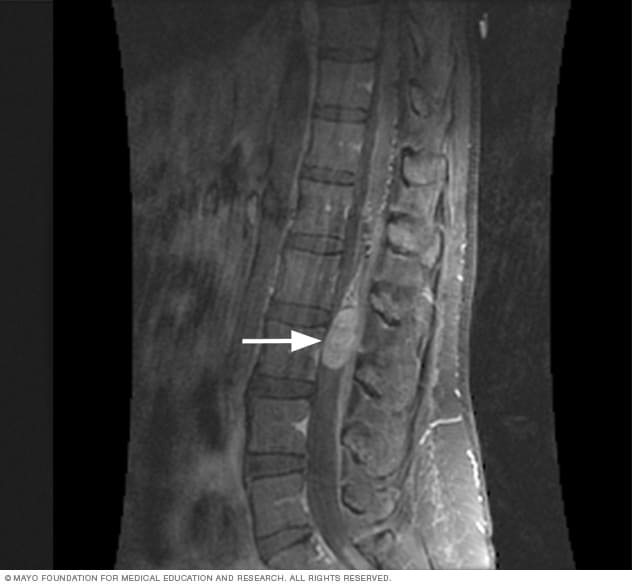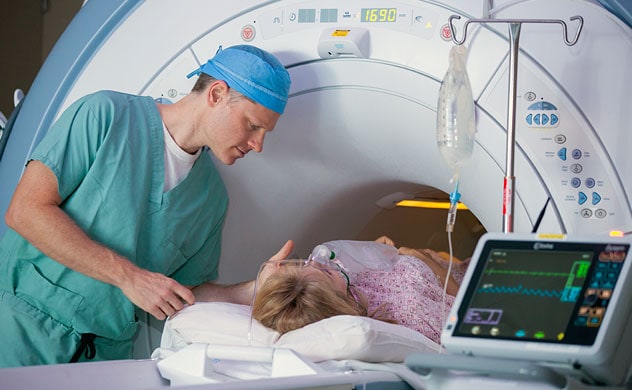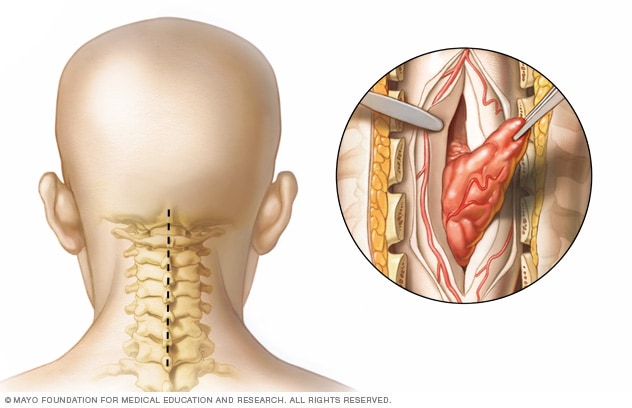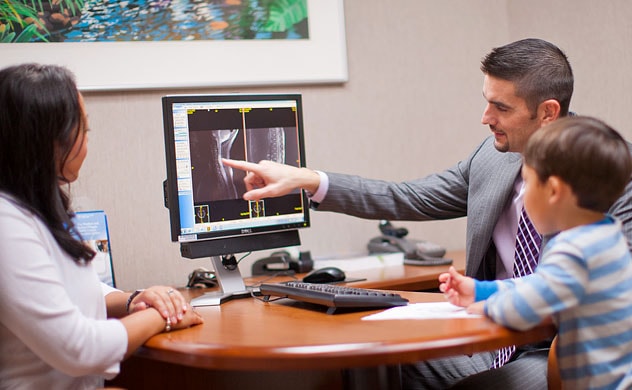Diagnosis
MRI scan of spinal cord tumor

MRI scan of spinal cord tumor
Spinal tumors sometimes might be overlooked because they're not common and their symptoms resemble those of more common conditions. For that reason, it's especially important that your doctor know your complete medical history and perform both general physical and neurological exams.
If your doctor suspects a spinal tumor, these tests can help confirm the diagnosis and pinpoint the tumor's location:
-
Spinal magnetic resonance imaging (MRI). MRI uses a powerful magnetic field and radio waves to produce accurate images of your spine, spinal cord and nerves. MRI is usually the preferred test to diagnose tumors of the spinal cord and surrounding tissues. A contrast agent that helps highlight certain tissues and structures may be injected into a vein in your hand or forearm during the test.
Some people may feel claustrophobic inside the MRI scanner or find the loud thumping sound it makes disturbing. But you're usually given earplugs to help with the noise, and some scanners are equipped with televisions or headphones. If you're very anxious, ask about a mild sedative to help calm you. In certain situations, a general anesthetic may be necessary.
 MRI scan
MRI scan
- Computerized tomography (CT). This test uses a narrow beam of radiation to produce detailed images of your spine. Sometimes it's combined with an injected contrast dye to make abnormal changes in the spinal canal or spinal cord easier to see. A CT scan is only rarely used to help diagnose spinal tumors.
- Biopsy. The only way to determine the exact type of a spinal tumor is to examine a small tissue sample (biopsy) under a microscope. The biopsy results will help determine treatment options.
More Information
Treatment
Ideally, the goal of spinal tumor treatment is to eliminate the tumor completely, but this goal may be complicated by the risk of permanent damage to the spinal cord and surrounding nerves. Doctors also must take into account your age and overall health. The type of tumor and whether it arises from the structures of the spine or spinal canal or has spread to your spine from elsewhere in your body also must be considered in determining a treatment plan.
Spinal tumor neck surgery

Spinal tumor neck surgery
Using microsurgical techniques, a tumor is gently teased out of the spinal cord in the cervical spine.
Treatment options for most spinal tumors include:
-
Monitoring. Some spinal tumors may be discovered before they cause symptoms — often when you're being evaluated for another condition. If small tumors aren't growing or pressing on surrounding tissues, watching them carefully may be all that's needed.
During observation, your doctor will likely recommend periodic CT or MRI scans at an appropriate interval to monitor the tumor.
-
Surgery.This is often the treatment of choice for tumors that can be removed with an acceptable risk of spinal cord or nerve injury damage.
Newer techniques and instruments allow neurosurgeons to reach tumors that were once considered inaccessible. The high-powered microscopes used in microsurgery make it easier to distinguish tumor from healthy tissue.
Doctors also can monitor the function of the spinal cord and other important nerves during surgery, thus minimizing the chance of injuring them. In some instances, very high-frequency sound waves might be used during surgery to break up tumors and remove the fragments.
But even with the latest technological advances in surgery, not all tumors can be totally removed. When the tumor can't be removed completely, surgery may be followed by radiation therapy or chemotherapy or both.
Recovery from spinal surgery may take weeks or longer, depending on the procedure. You may experience a temporary loss of sensation or other complications, including bleeding and damage to nerve tissue.
 Pediatric neurosurgery consultation
Pediatric neurosurgery consultation
-
Radiation therapy. This may be used to eliminate the remnants of tumors that remain after surgery, to treat inoperable tumors or to treat those tumors where surgery is too risky.
Medications may help ease some of the side effects of radiation, such as nausea and vomiting.
Sometimes, your radiation therapy regimen may be adjusted to help minimize the amount of healthy tissue that's damaged and to make the treatment more effective. Modifications may range from simply changing the dosage of radiation to using sophisticated techniques such as 3-D conformal radiation therapy.
-
Chemotherapy. A standard treatment for many types of cancer, chemotherapy uses medications to destroy cancer cells or stop them from growing. Your doctor can determine whether chemotherapy might be beneficial for you, either alone or in combination with radiation therapy.
Side effects may include fatigue, nausea, vomiting, increased risk of infection and hair loss.
-
Other drugs. Because surgery and radiation therapy as well as tumors themselves can cause inflammation inside the spinal cord, doctors sometimes prescribe corticosteroids to reduce the swelling, either after surgery or during radiation treatments.
Although corticosteroids reduce inflammation, they are usually used only for short periods to avoid serious side effects such as muscle weakness, osteoporosis, high blood pressure, diabetes and an increased susceptibility to infection.
More Information
Clinical trials
Explore Mayo Clinic studies testing new treatments, interventions and tests as a means to prevent, detect, treat or manage this condition.
Alternative medicine
Although there aren't any alternative medicines that have been proved to cure cancer, some complementary or alternative treatments may help relieve some of your symptoms.
One such treatment is acupuncture. During acupuncture treatment, a practitioner inserts tiny needles into your skin at precise points. Research shows that acupuncture may be helpful in relieving nausea and vomiting. Acupuncture might also help relieve certain types of pain in people with cancer.
Be sure to discuss the risks and benefits of complementary or alternative treatment that you're thinking of trying with your doctor. Some treatments, such as herbal remedies, could interfere with medicines you're taking.
Coping and support
Learning that you have a spinal tumor can be overwhelming. But you can take steps to cope after your diagnosis. Consider trying to:
-
Find out all you can about your specific spinal tumor. Write down your questions and bring them to your appointments. As your doctor answers your questions, take notes or ask a friend or family member to come along to take notes.
The more you and your family know and understand about your care, the more confident you'll feel when it comes time to make treatment decisions.
-
Get support. Find someone you can share your feelings and concerns with. You may have a close friend or family member who is a good listener. Or speak with a clergy member or counselor.
Other people with spinal tumors may be able to offer unique insights. Ask your doctor about support groups in your area. Online discussion boards, such as those offered by the Spinal Cord Tumor Association, are another option.
-
Take care of yourself. Choose a healthy diet rich in fruits, vegetables and whole grains whenever possible. Check with your doctor to see when you can start exercising again. Get enough sleep so that you feel rested.
Reduce stress in your life by taking time for relaxing activities, such as listening to music or writing in a journal.
Preparing for your appointment
If you have signs and symptoms that are common to spinal tumors — such as persistent, unexplained back pain, weakness or numbness in your legs, or changes in your bowel or bladder function, call your doctor promptly.
After your doctor examines you, you may be referred to a doctor who is trained to diagnose and treat cancer (oncologist), brain and spinal cord conditions (neurologist, neurosurgeon or spine surgeon), or disorders of the bones (orthopedic surgeon).
Here's some information to help you get ready for your appointment, and what to expect from the doctor.
What you can do
- Write down any symptoms you've been experiencing and for how long.
- List your key medical information, including all conditions you have and the names of any prescription and over-the-counter medications you're taking.
- Note any family history of brain or spinal tumors, especially in a first-degree relative, such as a parent or sibling.
- Take a family member or friend along. Sometimes it can be difficult to remember all of the information provided to you during an appointment. Someone who accompanies you may remember something that you missed or forgot.
- Write down questions to ask your doctor.
Questions to ask your doctor at your initial appointment include:
- What may be causing my symptoms?
- Are there any other possible causes?
- What kinds of tests do I need? Do these tests require any special preparation?
- What do you recommend for next steps in determining my diagnosis and treatment?
- Should I see a specialist?
Questions to ask an oncologist or neurologist include:
- Do I have a spinal tumor?
- What type of tumor do I have?
- How will the tumor grow over time?
- What might be the consequences?
- What are the goals of my treatment?
- Am I a candidate for surgery? What are the risks?
- Am I a candidate for radiation? What are the risks?
- Is there a role for chemotherapy?
- What treatment approach do you recommend?
- If the first treatment isn't successful, what will we try next?
- What is the long-term outlook for my condition?
- Do I need a second opinion?
In addition to the questions that you've prepared to ask your doctor, don't hesitate to ask any additional questions that may come up during your appointment.
What to expect from your doctor
Your doctor is likely to ask you a number of questions. Thinking about your answers ahead of time can help you make the most of your appointment. A doctor who sees you for a possible spinal tumor may ask:
- What are your symptoms?
- When did you first notice these symptoms?
- Have your symptoms gotten worse over time?
- If you have pain, where does the pain seem to start?
- Does the pain spread to other parts of your body?
- Have you participated in any activities that might explain the pain, such as a new exercise or a long stretch of gardening?
- Have you experienced any weakness or numbness in your legs?
- Have you had any difficulty walking?
- Have you had any problems with your bladder or bowel function?
- Have you been diagnosed with any other medical conditions?
- Are you currently taking any over-the-counter or prescription medications?
- Do you have any family history of noncancerous or cancerous spinal tumors?
Nov. 14, 2020